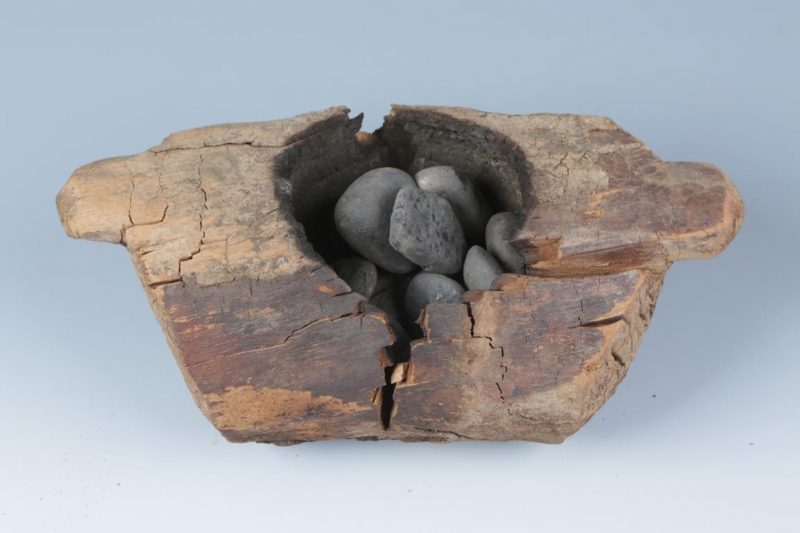High spirits: study finds cannabis first used in C. Asian funerals
Researchers discovered ten wooden braziers (or burners) containing stones with obvious burning traces from eight exhumed tombs at the site (Xinhua Wu)
Washington (AFP) – At a burial site high in the Pamir Mountains, music from an ancient harp and the smell of burning cannabis and juniper incense fill the air, part of an elaborate ceremony to commune with the divine — and the dead.
These rituals took place 2,500 years ago and represent the oldest known use of marijuana for its psychoactive properties, according to scientists who analyzed archeological remains in China’s western Xinjiang province using forensic technology.
Their findings were published in the journal Science Advances on Wednesday and place cannabis among the growing number of crops, from apples to walnuts, that researchers believe developed into their modern form along the Silk Road, said Robert Spengler, the study’s lead archaeobotanist.
“The exchange routes of the early Silk Road functioned more like the spokes of a wagon wheel than a long-distance road, placing Central Asia at the heart of the ancient world,” said Spengler, of the Max Planck Institute for the Science of Human History in Jena, Germany.
“Our study implies that knowledge of cannabis smoking and specific high-chemical-producing varieties of the cannabis plant were among the cultural traditions that spread along these exchange routes.”
This contrasts with the earlier domestication of less psychologically potent forms of cannabis in eastern China where hemp was grown for its oily seeds and durable fibers for clothing and cordage — a practice that began more than 6,000 years ago.
The present study examined the Jirzankal Cemetery which lies close to China’s border with Tajikistan and where excavation work began in 2013.
Researchers discovered ten wooden braziers (or burners) containing stones with obvious burning traces from eight exhumed tombs at the site.
The ancient cemetery is located more than 3,000 meters above sea level and has several notable characteristics.
Its surface is covered with black and white stones arranged into long strips, and dotted with numerous circular burial mounds with rings of stones underneath.
The mounds find parallels in contemporaneous burial sites throughout Central Asia, suggesting shared culture and beliefs, but the purpose of the burners was not immediately clear.
– Human sacrifice –
The scientists analyzed the wooden burners and the burnt stones using gas chromatography – mass spectrometry (GCMS), a technique that is often applied in forensic analyses but has only recently been used to investigate ancient remains.
It works by separating chemical mixtures and then identifying the components at the molecular level.
“To our excitement, we identified the biomarkers of cannabis notably the chemicals related to the psychoactive properties,” said Professor Yimin Yang, the lead analyst for the study at the University of the Chinese Academy of Sciences.
The cannabinoids detected on the wooden burners were mainly cannabinol (CBN), which is what the main psychoactive component of cannabis, tetrahydrocannabinol (THC), decomposes into when exposed to air.
This evidence — along with the recovery of other artifacts such as angular harps, an important musical instrument in ancient funerals, and burners made from juniper wood which release a potent turpentine fragrance — point to elaborate rituals carried out in a thick cloud of hallucinogen smoke guiding people into an altered state of mind.
Intriguingly, Yang told AFP one of the tombs contained the body of an individual who appeared to have died a natural death, along with others who had cut marks on their bones and skulls, which the excavators interpreted as signs of human sacrifice.
DNA analysis is now being attempted to try to determine whether they were related, he added.
– Cultivation or hybridization? –
According to Spengler, there are two theories for the emergence of cannabis with a higher THC content that the people of the region subsequently exploited.
Firstly, people may have been cultivating cannabis and actively selecting specimens with higher psychoactive properties, and even planting them on high elevations — a stressor that induces greater THC levels.
The alternate explanation is “hybridization,” the idea that “not all plants were domesticated through this long process of interaction with humans — some of them may have been rapidly domesticated by humans, simply moving them or transporting them.”
According to this theory, as people moved along the Silk Road’s trade routes they may have inadvertently spread seeds that allowed different species to breed, resulting in offspring with new traits.
The subject of early drug use in Central Eurasia has long intrigued historians and archaeologists, and the findings of the study appear to tally with an account by the ancient Greek historian Herodotus.
Writing in the fifth-century BCE, he described how people in the Caspian Steppe region would sit in a small tent and burn plants in a bowl with hot stones.
There is also a long history of inquiry over the identities of the mythical substance “soma” of the Rigveda, Hinduism’s oldest sacred text, and the “haoma” of Zorastrianism’s Avesta, a debate which Spengler hoped the study would revive.
“I would say we didn’t actually solve the soma debates in this study, but I would say hopefully, we resurrected the interest in studying the ancient use of plants in this part of the world,” he said.
Disclaimer: Validity of the above story is for 7 Days from original date of publishing. Source: AFP.


